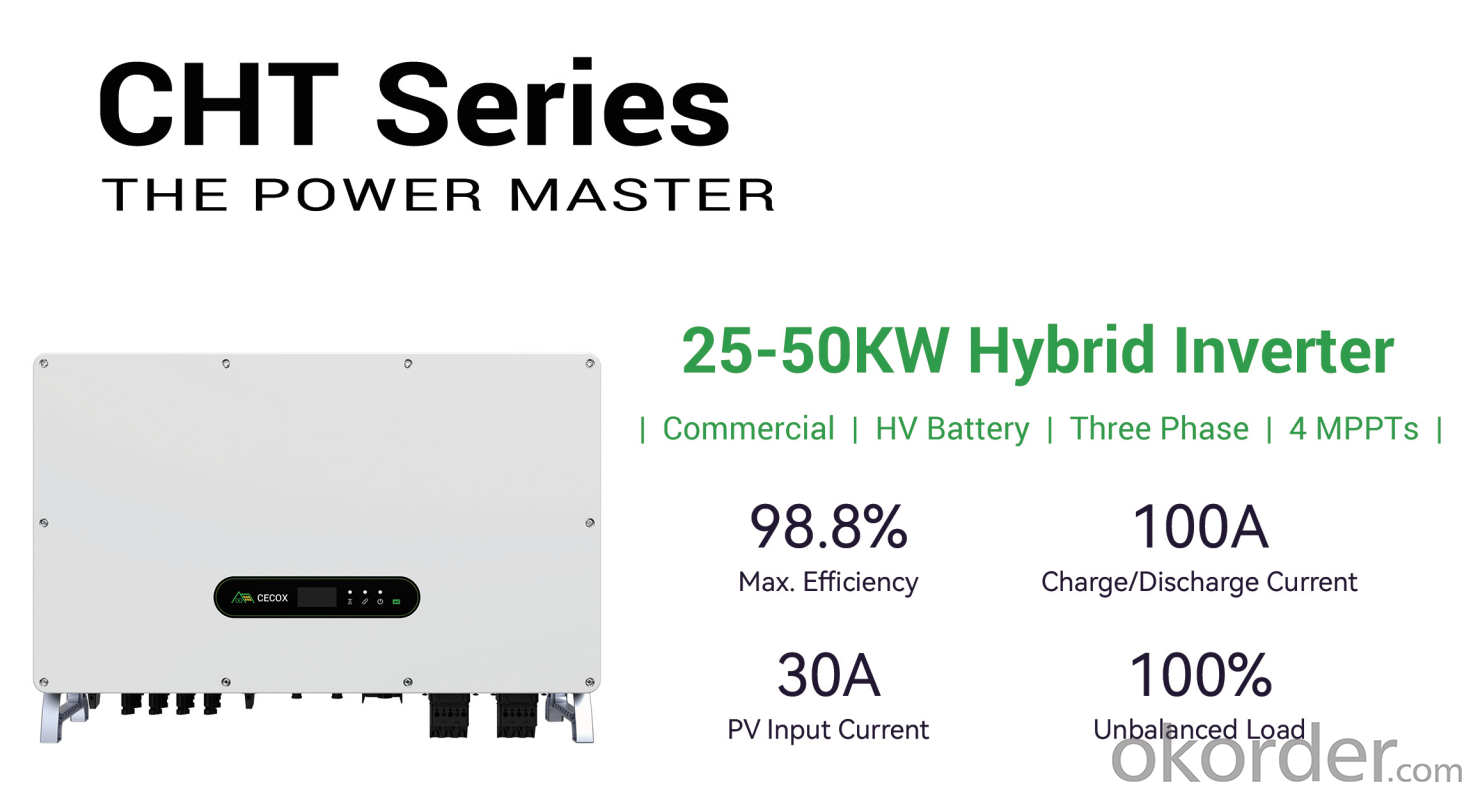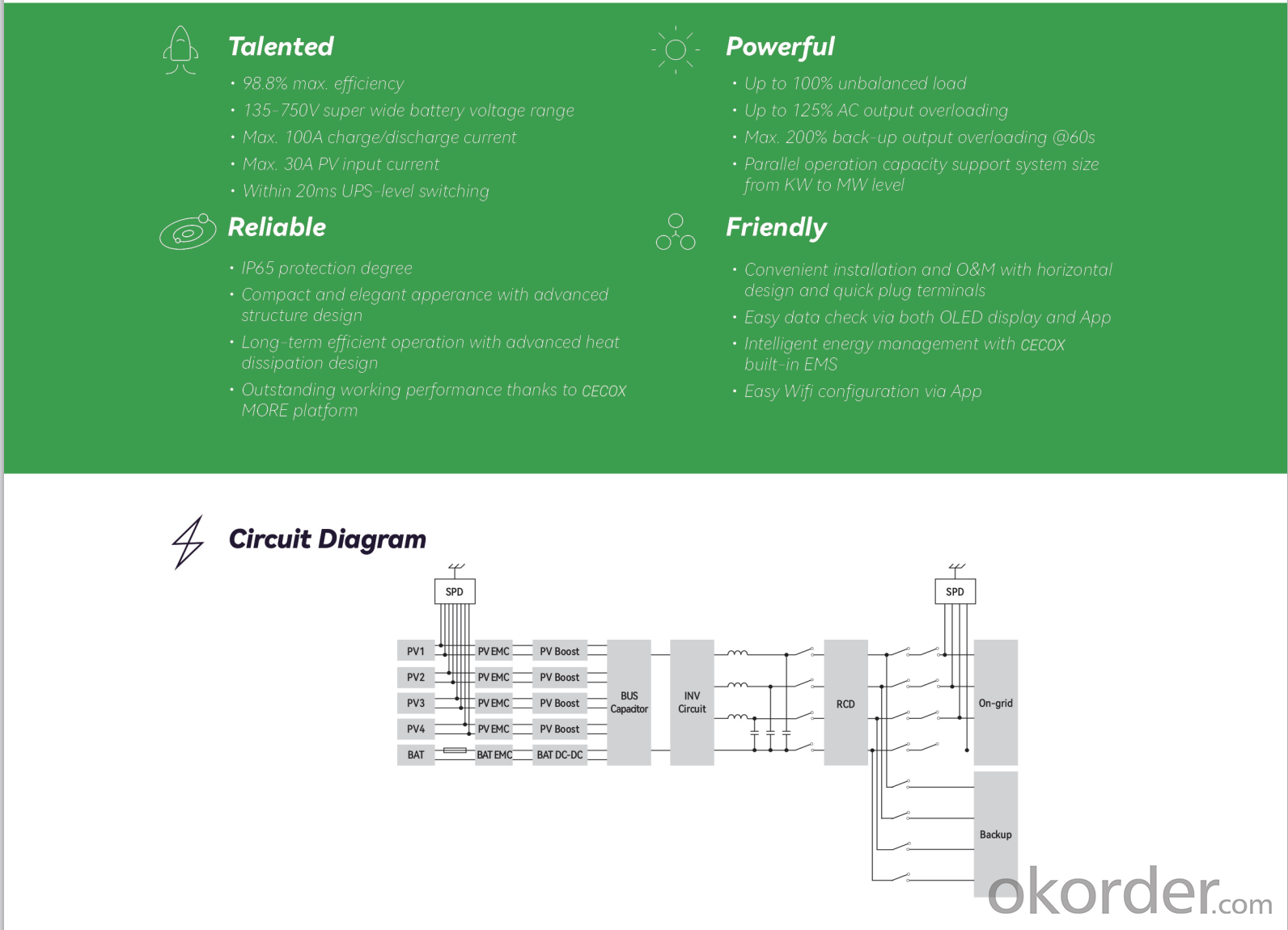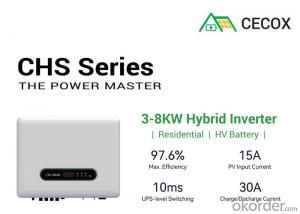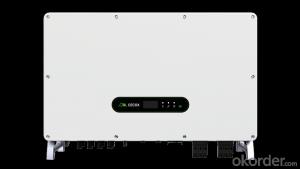Three Phase Solar 25kw 30kw 36kw 40kw50kw high voltage hybrid inverter Best Selling good price
- Loading Port:
- Stock in Panama
- Payment Terms:
- TT or LC
- Min Order Qty:
- 1 unit
- Supply Capability:
- 5000 unit/month
OKorder Service Pledge
Quality Product, Order Online Tracking, Timely Delivery
OKorder Financial Service
Credit Rating, Credit Services, Credit Purchasing
You Might Also Like
Item specifice
Output Power:
50kw
Inveter Efficiency:
98.8%
Output Voltage(V):
220/380v,230V/400V,240/415V
Input Voltage(V):
1000v
Output Current(A):
100A
Output Frequency:
50/60HZ



- Q:Can a solar inverter be used for off-grid systems?
- Yes, a solar inverter can be used for off-grid systems. In fact, it is an essential component of off-grid solar systems as it converts the DC (direct current) electricity generated by the solar panels into AC (alternating current) electricity that can be used to power household appliances and other electrical devices.
- Q:Can a solar inverter be used with a solar-powered air conditioning system?
- Yes, a solar inverter can be used with a solar-powered air conditioning system. The solar inverter converts the direct current (DC) electricity generated by the solar panels into alternating current (AC) electricity, which is used to power the air conditioning system. This allows the air conditioning system to run efficiently and effectively using solar energy.
- Q:Can a solar inverter be used with a hybrid solar system?
- Yes, a solar inverter can be used with a hybrid solar system. In fact, a solar inverter is an essential component of a hybrid solar system as it converts the DC power generated by the solar panels into AC power that can be used to power electrical devices or be fed into the grid. The inverter also allows for the seamless integration of other power sources, such as a battery storage system or a backup generator, in a hybrid solar system.
- Q:How do you troubleshoot common issues with a solar inverter?
- To troubleshoot common issues with a solar inverter, first, check the display panel for any error messages or indicators. If there are none, ensure that all connections, including DC and AC cables, are securely tightened. Next, verify if there is sufficient sunlight reaching the solar panels. If the issue persists, inspect the fuse or circuit breaker and replace if necessary. Additionally, investigate the inverter's performance logs to identify any irregularities. If these steps do not resolve the problem, it is recommended to consult a professional solar technician for further assistance.
- Q:How does a solar inverter handle ground fault protection?
- A solar inverter handles ground fault protection by continuously monitoring the flow of current between the solar panel array and the ground. If it detects any abnormal current leakage or ground faults, it quickly shuts down the system to prevent any potential electrical hazards or damage.
- Q:What is the role of Maximum Power Point Tracking (MPPT) in a solar inverter?
- The role of Maximum Power Point Tracking (MPPT) in a solar inverter is to optimize the power output from the solar panels by constantly adjusting the voltage and current to ensure that the solar panels are operating at their maximum power point. This allows the solar inverter to efficiently convert the DC power generated by the solar panels into AC power for use in homes or businesses. By tracking and adjusting the maximum power point, MPPT technology maximizes the overall energy production and improves the overall efficiency of the solar inverter system.
- Q:What is the role of a solar inverter in preventing overloading?
- The role of a solar inverter in preventing overloading is to monitor the flow of electricity from the solar panels and regulate the amount of power being generated and fed into the electrical grid. It ensures that the solar system operates within its capacity and prevents excessive power generation that could lead to overloading and potential damage to the system or the electrical grid.
- Q:What is the impact of temperature on the performance of a solar inverter?
- The impact of temperature on the performance of a solar inverter is significant. High temperatures can cause the efficiency of the inverter to decrease, resulting in a reduction in power output. This is due to the fact that electronic components inside the inverter operate less efficiently at high temperatures. Additionally, elevated temperatures can lead to increased thermal stress on the inverter, potentially shortening its lifespan. Therefore, it is important to carefully consider the temperature conditions and provide adequate cooling or ventilation for optimal performance and longevity of the solar inverter.
- Q:How does a solar inverter handle frequency variations in the grid?
- A solar inverter handles frequency variations in the grid by continuously monitoring the frequency and adjusting its own output accordingly. If the grid frequency increases, the inverter reduces its output to prevent overloading. Conversely, if the frequency decreases, the inverter increases its output to maintain a stable supply. This dynamic response ensures that the solar inverter efficiently synchronizes with the grid and contributes to grid stability.
- Q:What are the common maintenance requirements for a solar inverter?
- Some common maintenance requirements for a solar inverter include regular cleaning to remove dust and debris, checking for loose connections or wiring issues, monitoring performance and output levels, and ensuring proper ventilation to prevent overheating. It is also important to keep an eye on the inverter's display for error messages or any signs of malfunctioning. Regular inspections and maintenance by a qualified technician are recommended to ensure optimal performance and longevity of the solar inverter.
1. Manufacturer Overview |
|
|---|---|
| Location | |
| Year Established | |
| Annual Output Value | |
| Main Markets | |
| Company Certifications | |
2. Manufacturer Certificates |
|
|---|---|
| a) Certification Name | |
| Range | |
| Reference | |
| Validity Period | |
3. Manufacturer Capability |
|
|---|---|
| a)Trade Capacity | |
| Nearest Port | |
| Export Percentage | |
| No.of Employees in Trade Department | |
| Language Spoken: | |
| b)Factory Information | |
| Factory Size: | |
| No. of Production Lines | |
| Contract Manufacturing | |
| Product Price Range | |
Send your message to us
Three Phase Solar 25kw 30kw 36kw 40kw50kw high voltage hybrid inverter Best Selling good price
- Loading Port:
- Stock in Panama
- Payment Terms:
- TT or LC
- Min Order Qty:
- 1 unit
- Supply Capability:
- 5000 unit/month
OKorder Service Pledge
Quality Product, Order Online Tracking, Timely Delivery
OKorder Financial Service
Credit Rating, Credit Services, Credit Purchasing
Similar products
New products
Hot products
Related keywords






























